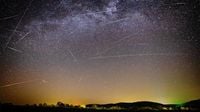As the skies darken across the Northern Hemisphere, sky gazers prepare for one of the oldest and most captivating celestial displays—the Lyrid meteor shower. This annual event, which runs from April 17 to April 26, peaks in the early hours of April 22, 2025, providing a spectacular opportunity for stargazers to witness shooting stars streaking across the night sky.
The Lyrid meteor shower occurs when Earth passes through the debris trail left by Comet C/1861 G1 Thatcher. This comet, discovered in 1861, takes approximately 415 years to complete its orbit around the Sun. As Earth intersects this trail, tiny particles of space debris enter our atmosphere, disintegrating and creating bright flashes known as meteors. Records of the Lyrids date back to 687 BCE, making it one of the oldest known meteor showers.
During the peak, viewers can expect to see anywhere from 10 to 20 meteors per hour, although conditions can sometimes lead to spectacular displays of up to 100 meteors in a single hour. Bill Cooke, who leads NASA's Meteoroid Environment Office, notes, "You will begin to see Lyrids after 10 p.m. local time." The best viewing times are typically after midnight until dawn, as the moon will be in its waning crescent phase, rising around 3 a.m. local time, thus minimizing interference with the visibility of the meteors.
For those hoping to catch the show, NASA recommends finding a location far from city lights. Ideal viewing conditions include lying flat on your back with your feet facing east, which allows for a broader view of the sky. After about 30 minutes in the dark, your eyes will adjust, enhancing your chances of spotting meteors. As Cooke advises, "Try not to look at your phone screen, as the light makes it harder for your eyes to adjust. Just stare up at the sky!"
While the Lyrids are known for their speed and brightness, they often do not leave long-lasting trails like some other meteor showers. Instead, they might produce occasional fireballs—intense bursts of light that can linger for several seconds. The radiant point of the Lyrids is located near the constellation Lyra, where the bright star Vega can be found. Vega is one of the easiest stars to locate in the night sky, and it will rise in the northeast during the evening hours.
This year, however, weather conditions may affect visibility for many observers. Forecasts indicate that parts of the northeastern United States, including areas like Bucks County, Pennsylvania, may experience cloudy skies that could obscure the view. Meanwhile, clearer conditions are expected further west and south, making regions like central Texas prime spots for viewing the Lyrids.
The Lyrid meteor shower is not just a beautiful spectacle; it also serves as a reminder of the dynamic and ever-changing nature of our solar system. As Earth continues its journey through the cosmos, these annual celestial events connect us to the universe in a profound way. With the Lyrids, skywatchers are invited to pause, look up, and appreciate the wonders of the night sky.
As excitement builds for this year's Lyrid meteor shower, enthusiasts are urged to prepare adequately for the experience. Experts recommend bringing warm clothing and a comfortable blanket or reclining chair to enhance the viewing experience. The best strategy is to find a dark spot, lie back, and enjoy the show as meteors dart across the sky.
In summary, the Lyrid meteor shower promises to be a dazzling display of nature’s beauty, with its peak occurring in the early morning hours of April 22. Whether you are a seasoned astronomer or a casual observer, this is an event not to be missed. So gather your friends, head out to a dark location, and get ready for a night of shooting stars!








